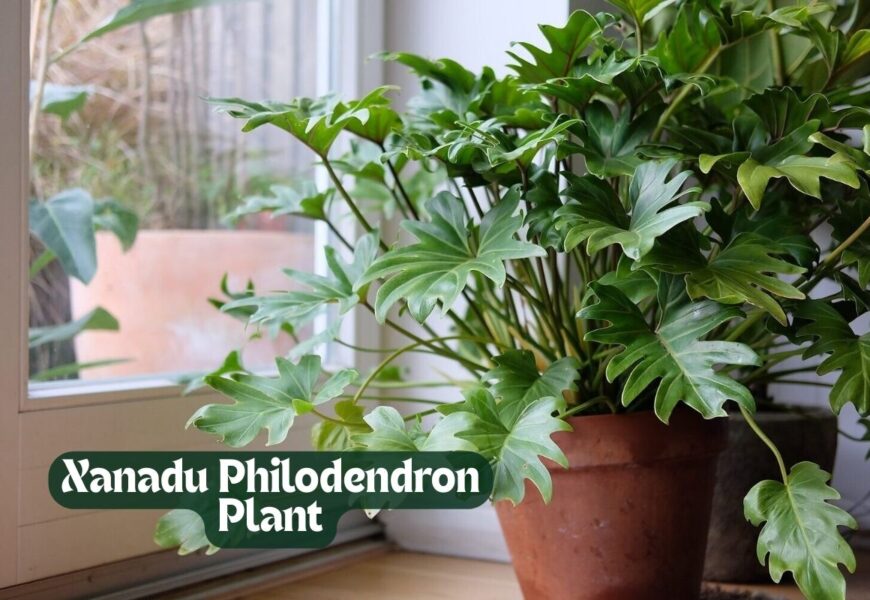Introduction to Philodendron Xanadu
The Xanadu Philodendron is a tropical foliage plant celebrated for its lush, deeply lobed leaves and compact, bushy growth habit. Unlike climbing philodendrons, Xanadu grows upright and forms a striking clump, making it an ideal choice for modern indoor spaces. Its vibrant green leaves bring a refreshing, natural charm while also helping to purify the air. Easy to care for and adaptable to a variety of home environments, it’s a perfect plant for both beginners and seasoned gardeners. With its blend of beauty and low maintenance, Xanadu stands out as one of the best indoor foliage options.
Growing and Caring for Xanadu Philodendron
To keep your Philodendron Xanadu healthy and thriving, it’s important to focus on the basics of its care. Here are the key requirements:
- Light: Prefers bright, indirect sunlight but can adapt to medium light conditions.
- Soil: Use a rich, well-draining potting mix with organic matter.
- Water: Keep soil evenly moist, watering when the top inch feels dry.
- Temperature & Humidity: Thrives in warm, humid environments similar to the tropics.
- Fertilizer: Feed monthly during the growing season with a balanced liquid fertilizer.
Pruning and Maintenance
Regular pruning helps the Xanadu Philodendron maintain its attractive, compact shape and prevents it from becoming leggy. Remove any yellowing or damaged leaves at the base to encourage fresh, healthy growth. Trimming back overgrown stems also allows better air circulation around the plant, reducing the risk of pests and fungal issues. Always use clean, sharp scissors or pruning shears to avoid infecting the plant. With routine care, Xanadu will stay lush, vibrant, and visually appealing indoors.
Propagation Methods
Propagating a Philodendron Xanadu is usually done through division, making it simple to multiply your plant. When repotting, carefully separate the root clumps, ensuring each section has a healthy root system and a few stems. Plant the divisions in fresh, well-draining soil and water lightly to help them settle in. Place the new plants in a warm spot with indirect light to encourage root establishment. With patience and proper care, these divisions quickly grow into full, lush plants.
Potting and Repotting Tips
The Xanadu Philodendron thrives best in a pot with good drainage to prevent root rot and soggy soil. Choose a container that’s only slightly larger than the root ball, as too much extra space can hold excess moisture. Repotting is usually needed every two to three years, or when roots start circling the pot and pushing through drainage holes. During repotting, refresh the soil mix with nutrient-rich, well-draining soil to support healthy growth. This routine ensures the plant remains vigorous, vibrant, and well-supported indoors.
Common Pests and Diseases
Although Philodendron Xanadu is generally hardy, it can occasionally attract pests such as spider mites, aphids, and mealybugs. These insects feed on the plant’s sap, causing yellowing leaves, stunted growth, or sticky residue on foliage. Regularly wiping the leaves and inspecting the undersides helps detect problems early. Overwatering can also lead to root rot and fungal infections, which weaken the plant. Using proper watering practices and natural pest control methods will keep your Xanadu healthy and thriving.
Troubleshooting Common Issues
Philodendron Xanadu may develop yellow leaves if it’s receiving too much water or not enough light. Brown leaf edges often signal low humidity, underwatering, or excessive direct sunlight. Monitoring soil moisture and adjusting the watering schedule usually resolves these problems. Keeping the plant in a bright spot with stable humidity levels also helps maintain vibrant foliage. Addressing these issues quickly prevents long-term damage and keeps the plant looking its best.
Styling and Placement Indoors
The Philodendron Xanadu makes a bold statement when placed in living rooms, offices, or entryways thanks to its lush, sculptural foliage. Its compact yet bushy growth allows it to complement both modern and traditional décor styles. Position it near windows with filtered light to highlight its vibrant green leaves while avoiding harsh direct sun. Large decorative pots can enhance its visual appeal, making it a natural focal point in any room. With thoughtful placement, Xanadu adds elegance and a refreshing touch of greenery to indoor spaces.
Alternative Philodendrons to Explore
If you love the Xanadu, there are many other philodendron varieties that can add unique beauty to your collection. Each offers distinct foliage colors, shapes, and growth habits:
- Philodendron Black Cardinal: Known for its deep burgundy leaves that mature to almost black.
- Philodendron Moonlight: Features bright lime-green foliage that adds a pop of color.
- Philodendron Royal Queen: Boasts glossy, dark leaves with a regal appearance.
- Philodendron Ring of Fire: Displays striking variegated leaves with fiery tones.
- Philodendron Plowmanii, Mayoi & Brandtianum: Offer textured or trailing forms for added variety.
Other Indoor Plants to Consider
Beyond philodendrons, several indoor plants can complement a Xanadu and enhance the greenery of your space. The Fiddle Leaf Fig, with its bold, violin-shaped leaves, makes a dramatic statement in living areas. Areca Palm and Schefflera bring tropical vibes while also helping purify the air. For smaller spaces, the Chinese Money Plant and Dieffenbachia add charm with their compact size and patterned leaves. Mixing these plants with Xanadu creates a balanced indoor garden full of variety and texture.
Seasonal Care Tips
Caring for a Xanadu Philodendron changes slightly with the seasons to keep it healthy year-round. In summer, the plant benefits from more frequent watering and occasional misting to handle higher temperatures and humidity. During winter, reduce watering as growth slows and ensure it stays away from cold drafts or heaters. Fertilizing should also be limited in the colder months and resumed in spring when active growth begins. Adjusting care with the seasons helps maintain vibrant foliage and long-term plant health.
Designing With Indoor Foliage
Incorporating a Philodendron Xanadu into your interior design brings a sense of freshness and natural elegance. Its bold, textured leaves pair beautifully with succulents, palms, and other foliage plants to create layered greenery. Grouping it with plants of different heights and colors adds depth and visual interest to any room. You can also use decorative pots or plant stands to highlight its shape and style. When thoughtfully arranged, Xanadu becomes both a living decoration and a key design element indoors.
Creating a Greener Home Environment
Adding a Philodendron Xanadu to your space not only enhances décor but also improves air quality by filtering indoor pollutants. Its lush greenery promotes a calming atmosphere, making homes feel more peaceful and inviting. Studies show that indoor plants can reduce stress, boost mood, and increase productivity. Placing Xanadu in shared living areas or workspaces brings both beauty and wellness benefits. With its low-maintenance nature, it’s an easy way to create a healthier, greener home.
Plant Shopping and Selection Tips
When buying a Philodendron Xanadu, look for plants with vibrant green leaves that are free from spots, yellowing, or wilting. Check the soil to ensure it’s not overly soggy, which could signal root problems. Inspect the stems and undersides of leaves for pests like mealybugs or aphids before purchasing. Choose a plant with a well-established root system, as this ensures better adaptation once brought home. Opting for healthy, nursery-grown specimens sets the foundation for long-lasting indoor success.
Conclusion
The Xanadu Philodendron is more than just an indoor plant—it’s a statement piece that combines elegance with easy care. With its lush, tropical foliage and compact growth, it brings both beauty and freshness to any living space. By providing the right light, water, and seasonal care, this plant can thrive for years while enhancing the ambiance of your home. Whether styled as a centerpiece or paired with other houseplants, it offers endless design possibilities. For anyone looking to create a greener, healthier, and more stylish indoor environment, this plant is a truly rewarding choice.















